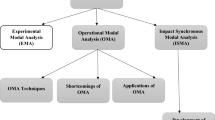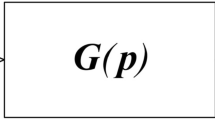Abstract
Based on the matrix mapping theory, an improved eigensystem realization algorithm (ERA), called C/ERA, is proposed in this paper. It rebuilds a Hankel matrix by replacing all elements of each anti-subdiagonal with the arithmetic average of the elements along the anti-subdiagonal, and introduces the concept of using the Frobenius norm (L2-norm) to control the iterations number after implementing the SVD algorithm by the ERA method. With the data associated with a 5-DOF mass-spring-dashpot system and jacket-type platform under impact loading, it is demonstrated that C/ERA has a better capacity of de-noising, and a higher accuracy for low-order modes, and can identify more high-order modes than the ERA method.











Similar content being viewed by others
References
Juang, J.N., Pappa, R.S.: Eigensystem realization algorithm (ERA) for modal parameter identification and model reduction. J. Guid. Control Dyn. 8(5), 620–627 (1985)
Hu, S.-L.J., Li, P., Vincent, H., Li, H.: Modal parameter estimation for jacket-type platforms using free-vibration data. J. Waterway Port Coast Ocean Eng 37(5), 45–53 (2011)
Xin, J.F., Sheng, J.L., Zhang, Y.B.: Data-driven stochastic subspace method selection and noise matrix dimension problem research. Vib. Shock 32(16), 152–157 (2013)
Cunha, A., Caetano, E.: Experimental modal analysis of civil engineering structures. Sound Vib. 40(6), 12–20 (2006)
Juang, J.N., Pappa, R.S.: Effects of noise on modal parameters identified by eigensystem realization algorithm. J. Guid. Control Dyn. 9(3), 294–303 (2015)
Cadzow, J.A.: Signal enhancement of composite property mapping algorithm. IEEE Trans. Acoust. Speech Signal Process. 36(1), 49–62 (1988)
Chu, M.T., Funderlic, R.E., Plemmons, R.J.: Structured low rank approximation. Linear Algebr. Appl. 366(2), 157–172 (2003)
Xin, J.F.: Study on modal parameter identification of offshore platform based on stochastic subspace method. Ocean University of China (2013)
ANSYS. Inc, ed.: ANSYS academic research. Release 9.0. Help System. Coupled Field Analysis Guide10 (2004)
Acknowledgements
The study has been supported by Natural Science Foundation of China (Grant No. 51609120), Science and Technology Plan for Shandong University(Grant No. J16LB7) and Qingdao Urban and Rural Construction Committee (Grant No. JK2015-15).
Author information
Authors and Affiliations
Corresponding author
Rights and permissions
About this article
Cite this article
Xin, J., Lei, W., Shixin, L. et al. Improved eigensystem realization algorithm and its application on ocean platforms. Cluster Comput 22 (Suppl 2), 3643–3650 (2019). https://doi.org/10.1007/s10586-018-2213-0
Received:
Revised:
Accepted:
Published:
Issue Date:
DOI: https://doi.org/10.1007/s10586-018-2213-0




